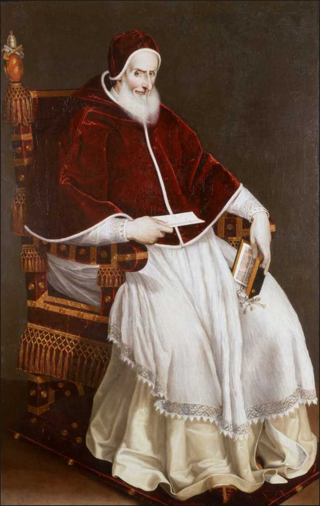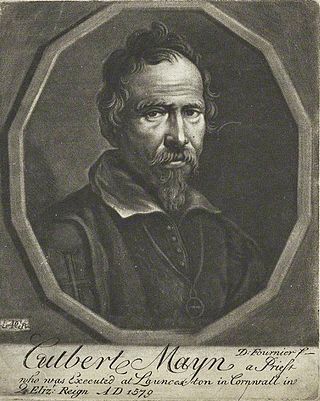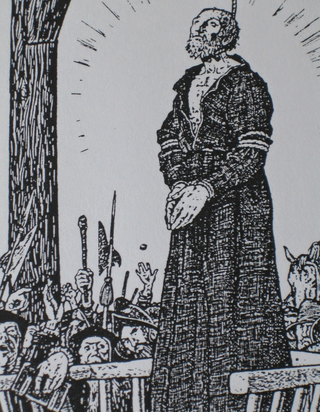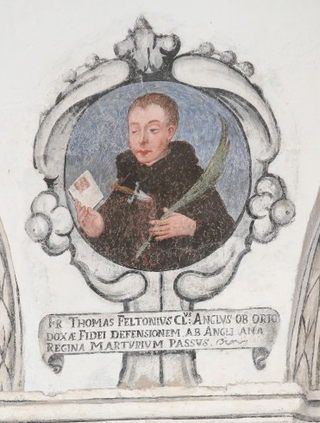Related Research Articles

Pope Pius V, OP, born Antonio Ghislieri, was head of the Catholic Church and ruler of the Papal States from 7 January 1566 to his death, in May 1572. He is venerated as a saint of the Catholic Church. He is chiefly notable for his role in the Council of Trent, the Counter-Reformation, and the standardization of the Roman Rite within the Latin Church, known as the Tridentine mass. Pius V declared Thomas Aquinas a Doctor of the Church.
In English history, the penal laws were a series of laws that sought to enforce the State-decreed religious monopoly of the Church of England and, following the 1688 revolution, of Presbyterianism in Scotland, against the continued existence of illegal and underground communities of Catholics, nonjuring Anglicans, and Protestant nonconformists. The Penal laws also imposed various forfeitures, civil penalties, and civil disabilities upon recusants from mandatory attendance at weekly Sunday services of the Established Church. The penal laws in general were repealed in the early 19th-century due to the successful activism of Daniel O'Connell for Catholic Emancipation. Penal actions are civil in nature and were not English common law.

Regnans in Excelsis is a papal bull that Pope Pius V issued on 25 February 1570. It excommunicated Queen Elizabeth I of England, referring to her as "the pretended Queen of England and the servant of crime", declared her a heretic, and released her subjects from allegiance to her, even those who had "sworn oaths to her", and excommunicated any who obeyed her orders: "We charge and command all and singular the nobles, subjects, peoples and others afore said that they do not dare obey her orders, mandates and laws. Those who shall act to the contrary we include in the like sentence of excommunication."

The Ridolfi plot was a Catholic plot in 1571 to overthrow Queen Elizabeth I of England and replace her with Mary, Queen of Scots. The plot was hatched and planned by Roberto Ridolfi, an international banker who was able to travel between Brussels, Rome and Madrid to gather support without attracting too much suspicion.
A priest hole is a hiding place for a priest built in England or Wales during the period when Catholics were persecuted by law. Following the accession of Queen Elizabeth I to the throne in 1558, there were several Catholic plots designed to remove her, and severe measures, including torture and execution, were taken against Catholic priests. From the mid-1570s, hides were built into houses to conceal priests from priest hunters. Most of the hides that survive today are in country manor houses, but there is much documentary evidence, for example in the Autobiography and Narrative of the Gunpowder Plot of John Gerard, of hides in towns and cities, especially in London.

Richard Reynolds, O.Ss.S was an English Bridgettine monk executed in London for refusing the Oath of Supremacy to King Henry VIII of England. He was canonised by Pope Paul VI in 1970, among the Forty Martyrs of England and Wales.

The Forty Martyrs of England and Wales or Cuthbert Mayne and Thirty-Nine Companion Martyrs are a group of Catholic, lay and religious, men and women, executed between 1535 and 1679 for treason and related offences under various laws enacted by Parliament during the English Reformation. The individuals listed range from Carthusian monks who in 1535 declined to accept Henry VIII's Act of Supremacy, to seminary priests who were caught up in the alleged Popish Plot against Charles II in 1679. Many were sentenced to death at show trials, or with no trial at all.

Cuthbert Mayne was an English Catholic priest executed under the laws of Elizabeth I. He was the first of the seminary priests trained on the Continent to be martyred. Mayne was beatified in 1886 and canonised as one of the Forty Martyrs of England and Wales in 1970.

Margaret Ball (1515–1584) was a prominent member of 16th-century Irish society, who, despite being the widow of a Lord Mayor of Dublin, was arrested for her adherence to the Catholic faith and died of deprivation in the dungeons of Dublin Castle. She was declared a martyr for the faith by the Catholic Church and beatified in 1992, one of a group of 17 Irish Catholic Martyrs.

John Story was an English Roman Catholic martyr and Member of Parliament. Story escaped to Flanders in 1563, but seven years later he was lured aboard a boat in Antwerp and abducted to England, where he was imprisoned in the Tower of London, and subsequently executed at Tyburn on a charge of treason.
The Rising of the North of 1569, also called the Revolt of the Northern Earls or Northern Rebellion, was an unsuccessful attempt by Catholic nobles from Northern England to depose Queen Elizabeth I of England and replace her with Mary, Queen of Scots.
Thomas Sherwood was a Catholic layman and martyr. He was arrested on suspicion of treason, having visited a house where it seems that Mass was secretly celebrated.
John Shert was an English Catholic priest and martyr, who was executed during the reign of Elizabeth I.

The Crown of Ireland Act 1542 is an Act that was passed by the Parliament of Ireland on 18 June 1542, which created the title of "King of Ireland" for monarchs of England and their successors; previous monarchs had ruled Ireland as Lords of Ireland. The first monarch to hold the title was King Henry VIII of England.

Robert Anderton was an English or Manx Catholic priest and martyr under the Elizabethan era religious persecution. Along with his companion, William Marsden, he was beatified by Pope Pius XI in 1929.

The Eighty-five Martyrs of England and Wales, also known as George Haydock and Eighty-four Companion Martyrs, are a group of men who were executed on charges of treason and related offences in the Kingdom of England between 1584 and 1679. Of the eighty-five, seventy-five were executed under the Jesuits, etc. Act 1584.
Events from the 1570s in England.

Anti-Catholicism in the United Kingdom dates back to the martyrdom of Saint Alban in the Roman era. Attacks on the Church from a Protestant angle mostly began with the English and Irish Reformations which were launched by King Henry VIII and the Scottish Reformation which was led by John Knox. Within England, the Act of Supremacy 1534 declared the English crown to be "the only supreme head on earth of the Church in England" in place of the Pope. Any act of allegiance to the latter was considered treasonous because the papacy claimed both spiritual and political power over its followers. Ireland was brought under direct English control starting in 1536 during the Tudor conquest of Ireland. The Scottish Reformation in 1560 abolished Catholic ecclesiastical structures and rendered Catholic practice illegal in Scotland. Today, anti-Catholicism remains present in the United Kingdom, particularly in Scotland and Northern Ireland.

Thomas Felton (1566?–1588) was a Franciscan Minim, a Roman Catholic martyr and son of the Roman Catholic martyr, John Felton.
References
Citations
- ↑ A History of the County of Surrey: Volume 2, Malden, H.E. (ed.), 1967. British History Online. Retrieved 14 May 2008.
- 1 2 Wainewright, John. "Blessed John Felton." The Catholic Encyclopedia. Vol. 8. New York: Robert Appleton Company, 1910. 28 May 2013
- 1 2 Camm O.S.B.,Dom Bede. "Blessed John Forest". Lives of the English Martyrs Declared Blessed by Pope Leo XIII, Vol. I, p. 2, Longmans, Green and Co., London 1914
- ↑ Starkey, David (2000). Elizabeth: The Struggle for the Throne . London: Harper Collins. p. 320. ISBN 0-06-018497-3.
- ↑ Haynes, Alan (2004). Walsingham: Elizabethan Spymaster and Statesman. Stroud, England: Sutton Publishing. p. 13. ISBN 0-7509-3122-1.
- 1 2 Jardine, David (1837). A Reading on the Use of Torture in the Criminal Law of England. London: Baldwin and Cradock. p. 78. OCLC 12055318.
- ↑ Lock, 2004
- ↑ Pollen, John (1891). Acts of English martyrs hitherto unpublished. London: Burns and Oates. p. 211. OCLC 1015792.
- ↑ "Special Oyer and Terminer Roll Principal Defendants and Charges: John Felton, high treason". Court of King's Bench: Crown Side: Baga de Secretis . Public Record Office . Retrieved 3 September 2010.
Sources
- Lock, Julian. "Felton, John". Oxford Dictionary of National Biography (online ed.). Oxford University Press. doi:10.1093/ref:odnb/9272.(Subscription or UK public library membership required.).
- The first edition of this text is available at Wikisource: . Dictionary of National Biography . London: Smith, Elder & Co. 1885–1900.